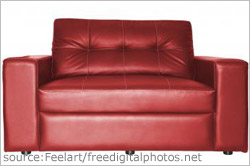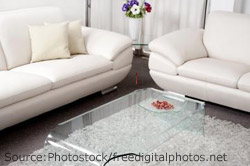
Leather furniture is luxurious, comfortable, and expensive. Unfortunately, life is full of accidents and even your valuable leather sofa is not immune to your cat's claws or an accidental scuff from a high heel.
Get tips and easy DIY-methods for repairing your lovely leather furniture from unattractive stains, punctures, scratches and tears.
Stains
There are several DIY methods for
treating spills and unsightly stains on your leather furniture. You should always test any method on a small, unnoticeable area of the furniture, and make sure the suggested solutions are permissible for the type of leather by contacting the retailer.
- Dark stains (mud, food, blood): Make a paste that's one part cream of tartar and one part lemon juice. Rub the mixture into the stain and allow it to sit for about 10 minutes. Remove the paste with a soap and distilled water-soaked cloth, wipe dry, and buff.
- Water stains: Wipe up water immediately after it's spilled with a soft cloth to avoid stains. If a stain forms from spilled water that's dried on the furniture, blend the stain with the surrounding area. Dampen a cloth with plain, distilled water and wipe outward from the center of the stain. Be gentle, and use a dry cloth to blend the water into the outer edges of the stain.
- Grease stains: Wipe up as much of the grease as you can immediately after a spill. Shake a layer of cornstarch onto the surface of the stain and allow it to sit for 10 minutes. Vacuum the starch off the stain using your soft brush attachment.
Scratches
Contact the leather furniture retailer first to inquire about any special care instructions before attempting any suggested methods on your own. Some types of leather will not respond to certain methods, and it's best to be sure you don't try anything that could make the problem worse. The company may even offer you a free repair or kit.
- For mild scratches, dab some olive oil or leather conditioner onto a clean, white cloth and rub onto the scratch in a circular motion. Don't drench the cloth in oil—excess will leave a noticeable stain on your sofa.
- Add heat from your blow dryer as you buff to bring the scratch to the surface and make it easier to remove.
- If the scratch still remains, place a damp, white cloth on top of the scratch. With your iron set to low, gently press just the tip of the iron onto the cloth for 10 seconds, which will bring the leather's natural oils out, and help repair the scratch. Make sure to never let the rest of the iron come into contact with the leather's surface.If the scratch remains, try once more.
- If the scratch still remains, you can try applying shoe polish in a color that matches your sofa. This method may only work for certain types of leather, so you may want to call the retailer before trying.
- Carefully apply the shoe polish to the scratch with a cotton swab, and quickly buff with a clean cloth. While this method won't eliminate a scratch, it may help conceal it. If the color does not match upon application, wash off the polish with a damp cloth immediately.
Tears and holes
For more noticeable holes and rips, you may have to allow a professional to repair your leather sofa. However, for smaller and less conspicuous punctures and tears, you can try one of these methods to take care of the problem on your own.
- Get a leather repair kit
- You can purchase a leather repair kit at most hardware or home goods stores. Make sure the kit you choose matches your sofa's color and leather grain as closely as possible.
- Read the instructions carefully before you begin.
The kit should come with a compound to spread over the affected area. Do so carefully, as illustrated in the directions.
- Cover the spot with grain papers, which should be included in your kit, until the color compound dries completely.Remove the papers by gently and slowly peeling them off.
 Fill and patch it yourself
Fill and patch it yourself
- If you're feeling extra crafty and ambitious, you can opt for the DIY route. First, clean the edges of the tear with alcohol, and cut away jagged edges with small, sharp scissors.
- Stuff the opening carefully with padding to maintain the shape of your sofa—cotton or foam will work best.
- Cover the padding inside the tear with a piece of subpatch paper, which can be purchased at a hardware retailer and will keep the tear from expanding. The paper is covered in adhesive, and when you press down on the leather surrounding the tear, it will stick to the paper, keeping the flaps around the tear secured. Use a hairdryer to melt the adhesive and make its hold stronger.
- Purchase a piece of leather (preferably in the same color as your sofa) and cut it to size so it will cover the tear. If you can't find the correct color, you can always paint it.
- Stick the piece of leather on top of the tear and use the hairdryer again to make the subpatch adhesive activate.
- For smaller tears, you can simply use leather adhesive along the edges of the tear and then apply the leather patch (eliminating the stuffing and subpatch paper).
- If you have any remaining scratches, sagging, or punctures, use a leather filler to conceal them. Once it dries, sand the imperfections with a small piece of sandpaper.
- Apply a leather conditioner to blend the patch into the rest of the sofa, and buff dry with a clean, white cloth.